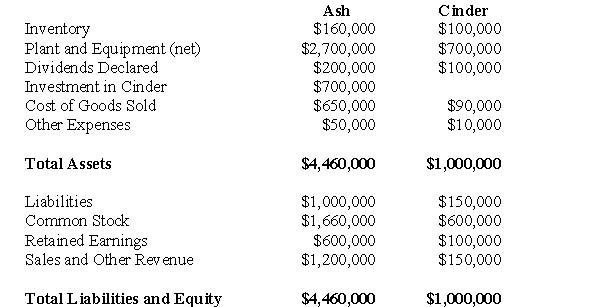The following information pertains to questions
The trial balances of Ash Inc.and its subsidiary Cinder Corp.on December 31,2006 are shown below:  Other Information:
Other Information:
Ash acquired Cinder in three stages:
January 1,2006: Ash purchased 10,000 shares for $100,000.Cinder's Retained Earnings were $40,000 on that date.
January 1,2008: Ash purchased 30,000 shares for $450,000.Cinder's Retained Earnings were $80,000 on that date.
December 31,2009: Ash purchased 20,000 shares for $150,000.Cinder's Retained Earnings were $100,000 on that date.
Cinder was incorporated on January 1,2004.On that date,Cinder issued 100,000 voting shares.Any difference between the cost and book value for each acquisition is attributable entirely to trademarks,which are to be amortized over 5 years.The company has neither issued nor retired shares since the Date of Incorporation.
Ash sold depreciable assets to Cinder at a loss of $20,000 on January 1,2008.These assets had a 10 year remaining life.
Intercompany Sales of Inventory amounted to $250,000.Unrealized inventory profits for each company are shown below for 2009.The amounts indicate the amount of profit in each company's inventory.  All inventories on hand at the start of 2009 were sold to outsiders during the year.The net Incomes of both companies are evenly earned throughout the year.Both companies are subject to an effective corporate tax rate of 20%.
All inventories on hand at the start of 2009 were sold to outsiders during the year.The net Incomes of both companies are evenly earned throughout the year.Both companies are subject to an effective corporate tax rate of 20%.
-Prepare an acquisition differential amortization table since the acquisition date.
Definitions:
Document Publisher
A software or service that enables the creation and distribution of documents in various formats.
Probability Sampling
A sampling technique where each member of a population has a known and often equal chance of being selected.
Purposive Sampling
A non-random sampling technique where subjects are selected based on their unique characteristics or qualities relevant to the research.
Snowball Sampling
A non-probability sampling technique where existing study subjects recruit future subjects from among their acquaintances.
Q1: What is the after-tax dollar value of
Q8: Which of the following is NOT a
Q14: Prepare a schedule of realized and unrealized
Q15: What kind of order is used to
Q18: Many large corporations have operation in many
Q20: Higher quality reports are more:<br>I. Relevant<br>II. Understandable<br>III.
Q24: If a parent company borrows money from
Q26: What is the after-tax dollar value of
Q39: Subject: home remedies for the common cold<br>Audience:
Q56: The amount of Accounts Receivable appearing on